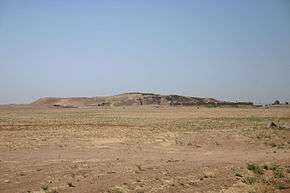Tell Beydar
 View of Tell Beydar from the north. | |
 Shown within Syria | |
| Location | Al-Hasakah Governorate, Syria |
|---|---|
| Coordinates | 36°44′16″N 40°35′13″E / 36.73778°N 40.58694°ECoordinates: 36°44′16″N 40°35′13″E / 36.73778°N 40.58694°E |
| Type | Settlement |
| History | |
| Founded | 2600 BC |
| Site notes | |
| Condition | In ruins |
Tell Beydar is a village and ancient site in the modern Al-Hasakah Governorate, Syria. It was the Ancient Near Eastern city of Nabada. It is connected by road to Al-Darbasiyah on the Turkish border in the north.
History
Nabada was first settled during the Early Dynastic period circa 2600 BC. By around 2500 BC a medium sized independent city-state had developed. At that point, it became a provincial capital under the kingdom centered at Nagar, now Tell Brak. After the Jezirah region was conquered by the Akkadians, Nabada became an outpost of that empire. The city was than abandoned until re-occupied for a time circa 1400 BC by the Hurrians and again in the Neo-Assyrian and Hellenistic periods.
Archaeology
The central site of Tell Beydar covers about 25 hectares (62 acres). A much later 50 ha (120-acre) Hurrian/Neo-Assyrian site lies at the base of the tell. At the top of the tell there is a Hellenistic settlement. Tell Beydar has been excavated for 16 seasons since 1992 by a joint Syrian and European team made up of the European Centre for Upper Mesopotamian Studies and the Directorate-General of Antiquities and Museums of Syria. The team leads are Marc Lebeau and Antoine Suleiman.[1][2][3][4][5][6][7][8][9] A number of other institutions, including the Oriental Institute of the University of Chicago have also participated. Besides the architectural and pottery findings from the excavation, almost 250 early cuneiform tablets and fragments were recovered, dating from the pre-sargonic period. The tablets are agricultural records for the most part, but do establish some synchronisms with Tell Brak. The language used in the tablets is a variant of the Semitic Akkadian language and the personal names referred to were also Semitic.[10] A number of clay sealing have also been recovered. Finds from Tell Beydar are on display in the Deir ez-Zor Museum.[11]
See also
Notes
- ↑ M. Lebeau, A. Suleiman , Tell Beydar, Three Seasons of Excavations (1992-1994). A Preliminary Report, ,David Brown, 1997, ISBN 2-503-50584-8
- ↑ M. Lebeau and A. Suleiman, Tell Beydar: The 1995-1999 Seasons of Excavations: a Preliminary Report, Brepols Publishers, 2003, ISBN 2-503-99117-3
- ↑ Marc Lebeau, Antoine Suleiman, Tell Beydar, the 2000-2002 Seasons of Excavations, the 2003-2004 Seasons of Architectural Restoration, Brepols Publishers, 2007, ISBN 2-503-51812-5
- ↑ Marc Lebeau and Antoine Suleiman, Report on the Twelfth Season of Excavations at Tell Beydar (2004)
- ↑ Marc Lebeau and Antoine Suleiman, Report on the 13th Season of Excavations and the 4th Season of Architectural Restoration at Tell Beydar (2005)
- ↑ Marc Lebeau and Antoine Suleiman, Report on the 14th Season of Excavations and the 5th Season of Architectural Restoration at Tell Beydar (2006)
- ↑ Marc Lebeau and Antoine Suleiman, Report on the 15th Season of Excavations and the 6th Season of Architectural Restoration at Tell Beydar (2008)
- ↑ Marc Lebeau and Antoine Suleiman, Report on the 16th Season of Excavations at Tell Beydar (2009)
- ↑ Marc Lebeau and Antoine Suleiman, Report on the 17th Season of Excavations at Tell Beydar (2010)
- ↑ Marc Lebeau and Antoine Suleiman, An Early Bronze Age City in the Syrian Jezirah: 10 Years of Research (1992-2002)
- ↑ Bonatz, Dominik; Kühne, Hartmut; Mahmoud, As'ad (1998). Rivers and steppes. Cultural heritage and environment of the Syrian Jezireh. Catalogue to the Museum of Deir ez-Zor. Damascus: Ministry of Culture. OCLC 638775287.
Further reading
- Peter M. M. G. Akkermans, Glenn M. Schwartz, The Archaeology of Syria: From Complex Hunter-Gatherers to Early Urban Societies (c.16,000-300 BC), Cambridge University Press, 2004, ISBN 0-521-79666-0
- F. Ismail, W. Sallaberger, P. Talon, K. Van Lerberghe, Administrative Documents from Tell Beydar, Seasons 1993-1995, Brepols Publishers, 1997, ISBN 2-503-50539-2
- L. Milano, W. Sallaberger, P. Talon, K. Van Lerberghe, Third Millennium Cuneiform Texts from Tell Beydar, Seasons 1996-2002, Brepols Publishers, 2004, ISBN 2-503-51542-8
- Joachim Bretschneider, Nabada: The Buried City, Scientific American, vol. 283, pp 74–81, 2000
- K. Van Lerberghe and G. Voet, Tell Beydar: Environmental and Technical Studies, Brepols, 2001, ISBN 2-503-99121-1
External links
- Tell Beydar excavation web site
- Clay tablet from Tell Beydar
- Oriental Institute Tell Beydar survey note from 97-98 season
- Oriental Institute Tell Beydar survey note from 98-99 season
| Wikimedia Commons has media related to Tell Beydar. |